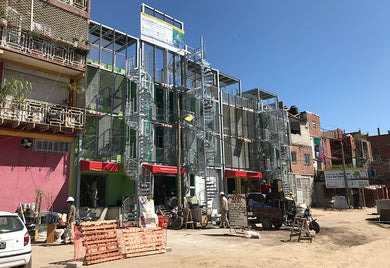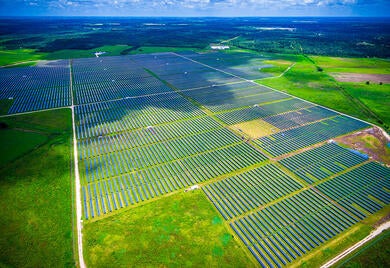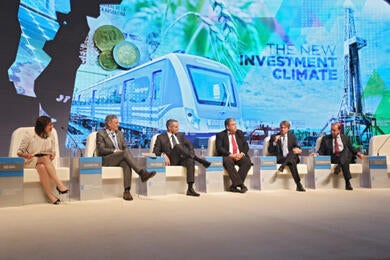
Unity is strength
The irruption of new players in the global commodities trade, greater consolidation of the multinationals, and the effects of climate change are forcing agricultural producers in Latin America and the Caribbean to rethink their strategies for minimizing risks and maximizing results on a sustainable basis. Realities and opportunities Although the research and development (R&D) investments of the “Big Four” (Bayer-Monsanto, ChemChina-Syngenta, Dow-Dupont, and BASF) achieved scientific advances that transformed global agriculture, expanded the agricultural frontier, and increased yields, producers face a dependence on technology and prices that is difficult to mitigate. Although in grains, companies like China’s COFCO or Japan’s Marubeni challenge the power of the ABCD (ADM, Bunge, Cargill, and Dreyfus), and demonstrate the strategic importance of ensuring the supply of commodities for some countries. In this fight, it is likely that corporate acquisitions will continue, or that new commodities platforms will be developed, creating opportunities for groups of producers, cooperatives, or business associations. Finally, the effects of climate change (rains, droughts, frosts, floods, cyclones, reduced aquifer flows, and new diseases) are affecting the producers’ profits, particularly in Central America where the narrow strip of land between two oceans makes climatic distortions even worse. Various ways to partner It is an historic reality that agricultural producers take the greatest risks but capture the smallest piece of the pie because of their fragmentation, difficulties in accessing financing, and minimum added value. However, producer partners in cooperatives that adapted to the dynamics of the market, through internal transformations (including advances in the management of corporate governance), were able not only to improve their incomes, but also to become part of a sustainable business, like Copersucar in Brazil, Conaprole in Uruguay, ACA in Argentina, FNC in Colombia, Colonias Unidas in Paraguay, or Dos Pinos in Costa Rica. In the case of independent larger-scale producers, although they will be able to maintain a certain individualistic profile internally to obtain efficiency and productivity, improving the external profitability is a must. They could take their inspiration from the spirit of cooperatives to create partnerships leveraging their combined volume (with increasing strategic value) and obtaining better conditions, or even process it for greater added value. For example, in Argentina, the 30 partnered producers of Bio4 transform their own and third-party corn to produce ethanol, and the “L” Group partners to sell milk. Similarly, in Mexico, the partnered producers of Proaoass and Gradesa export bread wheat or durum wheat. Although the greatest challenge for farmers under this model was to remain united, and in some cases to delegate the management of the new business to third-party professionals, they were also focused on obtaining better economic results, and also to develop a platform to start new businesses and obtain market intelligence. Looking ahead It is likely that differences in results among producers of a similar scale are due to: (1) more collective than individual actions; (2) a more business-like profile for sustainable production; and (3) the management of individuals or teams that applied the best technology packages. Considering that quasi-state companies, and sovereign funds from Asia-Pacific and Middle East countries are seeking alternatives to ensure the food supply, soon it would not be utopic to think that networks of partnered producers or cooperatives may develop strategic alliances to have their own ports, freezers, or powdered milk plants. Moreover, since these investments require long-term financing, it would not be unrealistic to think that development banking will be financing these projects. As Seneca said: “It is not because things are difficult that we do not dare, it is because we do not dare that things are difficult.” Subscribe to receive more content like this! [mc4wp_form]

Latin America needs more broadband to capitalize on the data explosion
There are many stories about the origins of chess. To me, the most colorful is about a king in India who was given a new game consisting of two armies and 64 squares, to overcome the loss of a son in the battlefield. The king was so delighted with this new game that he offered to give the inventor anything he wished for as compensation: “Give me one grain of rice for the first square, two grains for the second square, four grains for the third square, and so on for each of the squares of the game board,” said the inventor.

How we incentivize social inclusion through Sustainable Infrastructure? The case of Villa 31
Recently I visited the Villa 31 in Buenos Aires, Argentina. It is a poor and informal neighborhood located at approximately 500 meters from La Recoleta, one of the most sophisticated areas of the Argentinian capital. Despite this proximity, near 45,000 residents at Villa 31 have lived in isolation, not accepted as true “porteños” by their neighbors due to the social and economic characteristic of their community. My hope is that a new development project of sustainable infrastructure in the area changes this scenario. During my visit, I met fantastic people, but I experienced a strong mix of feelings. 20 years ago, I worked on an urban rehabilitation project in Brazil, which provided new homes, electricity, water, and sanitation to hundreds of low income people. By the end of the project, high-level dignitaries from the Government and other entities visited the new homes. One of them approached a woman benefited by the project and asked: “Are you happy? Is your life better?” She looked at him and said: “No, I am much worse off today. Before the project, I lived in a shack, I had no light, no water, no job, but no bills either. Now I have been given this nice house with bills to pay, but I still do not have a job. I do not know what to do”. 20 years after, I still carry this experience with me, even though we have learned a lot about urban development and inclusion projects ever since. The number of success stories has been growing, but its nature remains rather complex and represents a significant challenge to governments, policy makers, and financiers alike. According to an Inter-American Development Bank report: “Poverty-targeted projects that did not include specific objectives to reach excluded populations often reinforced their exclusion”. We must avoid this at all cost and work on the inclusion since the beginning. From Villa 31 to Villa “Thirty and Everyone” Working on sustainable infrastructure is not only about building new houses, but to improve the entire ecosystem around them to mobilize more human and economic resources that help people to break the poverty cycle. Villa 31 is not an isolated case. In Latin American and the Caribbean cities, informal areas can concentrate up to 50% of its habitants, and according the estimates, these number will keep rising. Development processes must include habitants’ perspective. Local communities have a voice, and the fact that we are listening to them makes a huge difference in terms of long-term acceptance, appropriation and viability. During my days at the Villa, I saw the construction taking place and the physical infrastructure being implemented. The work on water, sanitation, accessible roads, energy and electrified systems at Villa 31 is allowing its inclusion into Buenos Aires. More importantly, I saw people smiling and the pride on their eyes not only for the new structures, but for having a voice and being really included. So much that the initiative has been called Treinta y Todos (“Thirty and Everyone”) by Horacio Rodríguez Larreta, Buenos Aires city Mayor. This project has renewed people’s belief that their children would have the opportunity to live a different and better life, which is an essential success factor in such complex situation. Walking the talk at the Villa The feeling when leaving Villa 31 was completely different to what I felt 20 years ago, after our conversation with that woman in Brazil. I saw a high sense of trust and hope, so high that residents are already investing their own capital on improving their homes and establishing new business, such as: restaurants or beauty shops. Complementary initiatives like these are key, considering near 70% of the urban population of Latin America and the Caribbean works in the services sector, according UN-Habitat. A new socio-economic dynamic is developing, and some important external factors are fueling the process forward. The decision to establish a major government office building from the Education Ministry at the Villa provides a strong signal. However, it is not the only one. At the Inter-American Development Bank Group (IDB Group) we firmly believe in ‘walking the talk’, and the construction of the new Argentinian representation in Villa 31 shows it. This is a bold sign of commitment to the country and, more importantly, to the people. As part of the IDB Group, IDB Invest (formerly known as Inter-American Investment Corporation) is mobilizing resources and creating financial tools to stimulate private investments on these projects. Other public and private institutions should learn about the changes at the Villa, and hopefully decide to stand up and support this process too. [gallery type="slideshow" link="file" size="full" ids="7752,7753,7755,7757,7758,7759"] Subscribe to receive more content like this! [mc4wp_form]

Four countries leading in solar in Latin America and the Caribbean
Nearly half of the global electric power capacity could come from solar energy by 2025, according to McKinsey & Company. Multiple Latin American and Caribbean countries, benefitting from exceptional resources and evolved regulatory frameworks, have seen rapid growth in solar energy in the last few years. Utility scale projects are now considered commercially viable and receive private financing, while the application of distributed solar is growing quickly. However, falling solar prices are squeezing the industry, and macroeconomic uncertainty will continue to test its strength. Meanwhile, developers are now consolidating to gain market share and achieve profitability.

How Argentina can attract the private sector
This week I had the opportunity to participate in the Argentina Business and Investment Forum in Buenos Aires. The world has been watching as the country took center stage to start the conversation with the private sector and discuss ways to open its markets to the world.

Why is mobile broadband quality so important for development?
Latin America and the Caribbean is a region of contrasts. Almost everyone has a cell phone, as evidenced by the exponential increase in mobile phone subscribers from 10% of the population in 2000 to over 70% in 2017. And, the region is home to some of the most advanced mobile internet and avid social media users in the world, led by Mexico, Argentina, and Brazil. Yet coverage varies across countries and millions of people still do not have access to reliable mobile broadband connections, particularly in rural areas. And, even for those with access, service quality is often poor, limiting their potential to take full advantage of the latest technologies and making it difficult to bridge the digital divide.